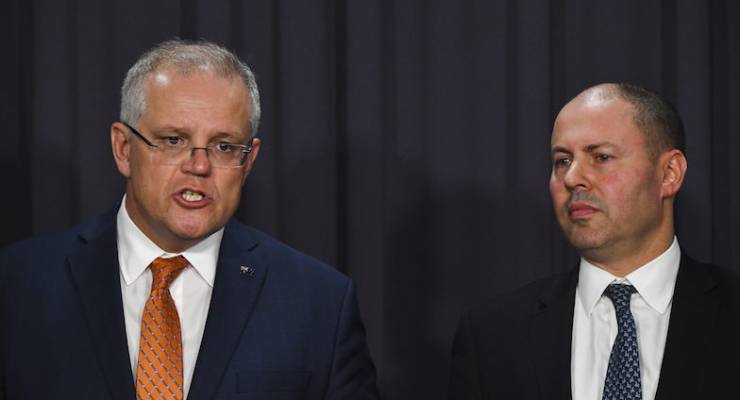
At $130 billion, it’s the biggest backflip in Australian political history, and the most welcome.
In less than a week, Scott Morrison has gone from calling an economy-wide wage subsidy scheme “dangerous”, claiming it would require a whole new payments system and couldn’t be done quickly, to announcing $130 billion over two quarters, to be delivered from the start of May via the tax system. And it’s more comprehensive in some areas than the UK wage subsidy scheme, though less so in terms of the proportion of wages subsidised.
All the problems of such a scheme are present. It will create perverse incentives, there are arbitrary and perhaps unfair thresholds (especially around casual workers), there are opportunities for gaming.
But those problems could only be mitigated, not removed, by complicated program design, when we need the package to roll out as quickly as possible.
The sheer quantum of money this will push into the economy at a point where employment is collapsing and GDP is likely falling by double digits is the most important aspect, not design details. That will be crucial in softening the colossal blow our response to the virus is inflicting.
And the preservation of businesses, the continuing employment of workers and the preservation of our economic infrastructure will enable a much faster rebuilding of the economy once the crisis has passed.
There’s another benefit that is less obvious but also important. The government is currently engaged in a desperate effort to get well over one million people into the welfare system to enable them to access Jobseeker payments. Last week’s debacle with Centrelink queues and MyGov was only the public part of a monumental challenge to the existing transfer system — one that has been geared to demonising and punishing recipients, not caring for them.
Now public servants are being redeployed by the thousands to call centres and other parts of Services Australia to cope with the vast logistical exercise that is adding such a huge number to a complex system in a short space of time.
The Jobkeeper payment will — hopefully — reduce that pressure. And to the extent that it prevents official unemployment figures from soaring well into double figures, it will facilitate a more rapid recovery.
The experience of previous recessions is that each month’s unemployment data becomes a national barometer of wellbeing, and the higher the number goes, the more gloom is spread, and the more people hunker down and curb spending.
If the Jobkeeper payments mean unemployment reaches 9% instead of 12%, it will have a major difference in terms of the post-virus economy.
Of course there’s the question of how such a remarkable sum will be paid for. We’re now looking at $100 billion deficits this year and next. But Australia has a strong balance sheet, and net debt — as of December — of 19.5% of GDP. That will now rise to at least 31% of GDP, but that’s still relatively modest by international standards.
But really, the question is not whether we can afford this — we can — but whether we can afford not to do it. A protracted, self-sustaining recession; a financial crisis precipitated by the mass defaulting of small business borrowers and residential mortgage holders; the long years history tells us are needed to reduce the level of unemployment back down to its current level — all will cost more in lost growth and shattered lives than government borrowings at historic low interest rates.
There’s no guarantee that this package will stave off those outcomes, but Morrison and Josh Frydenberg won’t die wondering. At this stage of an unfolding and unpredictable catastrophe, that’s all we can ask for.








We can afford it.
Have a listen to this podcast of an interview Alan Kohler had with Prof Bill Mitchell last week
Good questions and informative answers.
http://bilbo.economicoutlook.net/blog/?p=44603
Of course we can afford it, Ken- but that won’t stop the Government making us “pay for it” with austerity when this all over. There’s no major change to capitalism going on right now- the state is bailing it out by socialising its losses. The scale’s much bigger, of course, but it’s not new.
Capitalism want socialist policy so they can access taxpayer funds to remain profitable
Thanks Ken, 2 of my favourite economic thinkers/writers.
…. Another Schemo-Fraudberg “Anything, as long as they’re not thinking about a lock-down, that could end this quicker.”? …..
Trying to get blood back into a ‘public service’ system they’ve systematically emasculated for years while vilifying the unemployed and those most needy of welfare for votes. And still ‘casuals’ are discriminated against.
How are they going to screw us plebs to pay for, and claw their outlay back, after this is all over?
How many businesses will work a out way to rort this?
So there is JobKeeper Payment (ATO), not to be confused with JobSeeker Payment (Clink). Come on you marketing geniuses, what’s next?
That’s why iot took so long to come up with this policy – they were trying to find the right name.
It is odd that other governments are using such payments to cover furloughed workers – not those still working.
That would be canyon too far for this lot – the thought of people getting money whilst idle would cause their heads to explode.
Why all the breast beating about how we’re going to pay for it all. A quick check on the internet tells us WW2 cost 4 trillion dollars plus. Post war, despite taxing the wealthy a top rate of up to 90+%, there were boom times all around. Maybe someone could explain (in simple language) why this is different?
Just guessing but maybe tax avoidance had not become the major industry it is today?
Governments had sufficient coin to pay for the services, council housing & welfare states which then created the boom times.
Trouble is, people became comfortable and forgot that taxes buy civilisation, hence the bleakness that passes for modern, dog-eat-dog society.